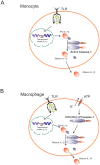IL-1beta processing in host defense: beyond the inflammasomes
- PMID: 20195505
- PMCID: PMC2829053
- DOI: 10.1371/journal.ppat.1000661
IL-1beta processing in host defense: beyond the inflammasomes
Abstract
Stimulation and release of proinflammatory cytokines is an essential step for the activation of an effective innate host defense, and subsequently for the modulation of adaptive immune responses. Interleukin-1beta (IL-1beta) and IL-18 are important proinflammatory cytokines that on the one hand activate monocytes, macropages, and neutrophils, and on the other hand induce Th1 and Th17 adaptive cellular responses. They are secreted as inactive precursors, and the processing of pro-IL-1beta and pro-IL-18 depends on cleavage by proteases. One of the most important of these enzymes is caspase-1, which in turn is activated by several protein platforms called the inflammasomes. Inflammasome activation differs in various cell types, and knock-out mice defective in either caspase-1 or inflammasome components have an increased susceptibility to several types of infections. However, in other infections and in models of sterile inflammation, caspase-1 seems to be less important, and alternative mechanisms such as neutrophil-derived serine proteases or proteases released from microbial pathogens can process and activate IL-1beta. In conclusion, IL-1beta/IL-18 processing during infection is a complex process in which the inflammasomes are only one of several activation mechanisms.
Conflict of interest statement
The authors have declared that no competing interests exist.
Figures



References
-
- Marodi L, Korchak HM, Johnston RB., Jr Mechanisms of host defense against Candida species. 1. Phagocytosis by monocytes and monocyte-derived macrophages. J Immunol. 1991;146:2783–2789. - PubMed
-
- Taylor PR, Martinez-Pomares L, Stacey M, Lin HH, Brown GD, et al. Macrophage receptors and immune recognition. Annu Rev Immunol. 2005;23:901–944. - PubMed
-
- Orange JS, Ballas ZK. Natural killer cells in human health and disease. Clin Immunol. 2006;118:1–10. - PubMed
-
- Ottenhoff TH, Verreck FA, Lichtenauer-Kaligis EG, Hoeve MA, Sanal O, et al. Genetics, cytokines and human infectious disease: lessons from weakly pathogenic mycobacteria and salmonellae. Nat Genet. 2002;32:97–105. - PubMed
Publication types
MeSH terms
Substances
LinkOut - more resources
Full Text Sources
Miscellaneous

